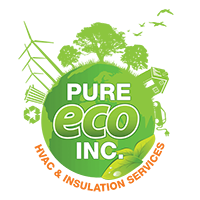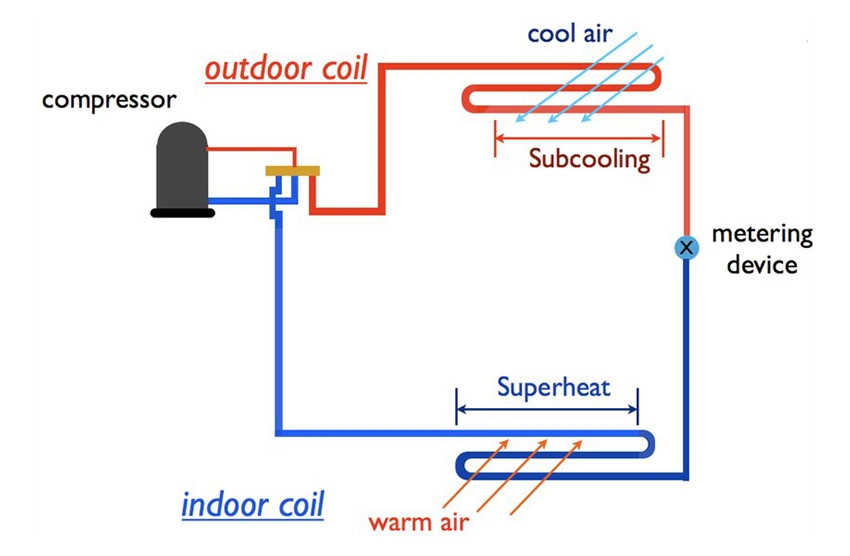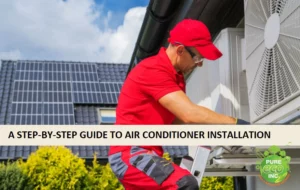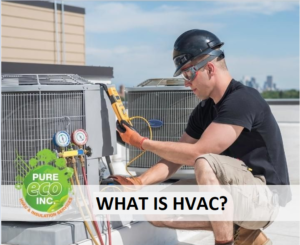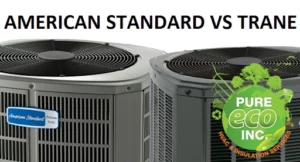If you hear your HVAC expert talk of superheat and subcool you might wonder what they are talking about.
Superheat is the temperature of refrigerant vapor above its boiling point, which makes sure the refrigerant remains in vapor form as it exits the evaporator coil.
Subcooling, on the other hand, is the temperature of the refrigerant liquid below its boiling point, which guarantees that the refrigerant stays in liquid form as it leaves the condenser.
Superheat and subcooling in HVAC are crucial concepts because they ensure your HVAC system works efficiently and effectively. There is a fine balance when the refrigerant flows through the system as it should and provides optimal cooling and heating without wasted energy.
As HVAC experts here at Pure Eco Inc., we keep a close eye on the refrigerant of your HVAC system. We are happy to provide you with a free consultation- 18778707998 to answer all your questions.
What is Superheat in HVAC?
Superheat in HVAC refers to the amount of heat of the refrigerant vapor that exceeds its boiling point. It’s the extra heat added to the vapor so that it remains in a gaseous state as it exits the evaporator coil. This crucial deviation from saturation temperature ensures that the refrigerant can absorb heat efficiently. That’s how the cooling process within the HVAC system works.
Superheat is important in the refrigeration cycle because it prevents the formation of unwanted liquid refrigerant at the evaporator’s outlet. This phenomenon guarantees that only superheated vapor, which is essential for efficient heat transfer, enters the compressor.
By maintaining the refrigerant in a gaseous state, superheat optimizes the cooling and dehumidifying functions of the HVAC system and contributes to its overall performance and energy efficiency.
Get Free Estimate!
Request Your Home Comfort Estimate
Determining Superheat – The Measurement Process
As HVAC experts, we calculate superheat precisely with specific tools designed for HVAC professionals. The most common instrument is the suction pressure gauge which determines the temperature and pressure of the refrigerant. Additionally, a digital thermometer and a pressure-temperature (P-T) chart come in handy in the process.
Step-by-Step Measurement Process
Follow the steps below to accurately measure superheat and maintain the optimal performance of your HVAC system to ensure that your home keeps a comfortable indoor temperature.
- Let the HVAC system operate first for 15 to 20 minutes to ensure precision in your measurements.
- Before starting, ensure that your HVAC system is safe to work on. Shut off the power and allow the system to stabilize.
- Identify the suction line and the evaporator coil. The suction line is where you’ll measure the temperature, and the evaporator coil is where you’ll measure the pressure.
- Attach the pressure gauge to the low-pressure side (suction line) and the digital thermometer to the refrigerant line. Make sure they are securely connected.
- Record the pressure reading from the pressure gauge and cross-reference it with the P-T chart to find the corresponding saturation temperature.
- Use the digital thermometer to measure the actual temperature of the suction line. This temperature should be above the saturation temperature obtained in the previous step.
- The superheat is determined by subtracting the saturation temperature from the actual temperature. The result is the superheat value in degrees Fahrenheit.
What is Subcooling in HVAC
Subcooling refers to the process of lowering the temperature of the refrigerant liquid below its saturation point to keep it in a purely liquid state. Subcooling ensures that the refrigerant remains entirely in liquid form as it exits the condenser unit.
The importance of subcooling lies in its direct impact on new system efficiency. When the refrigerant leaves the condenser as a subcooled liquid, it ensures that the liquid refrigerant is ready to absorb heat efficiently in the evaporator coil. This promotes superior cooling and dehumidification while optimizing the overall performance of the HVAC system.
Ensuring Proper Subcooling
Your HVAC system will operate at peak performance with the right maintenance and servicing.
Guidance on Checking and Maintaining Subcooling Levels
To measure subcooling, you’ll need a digital thermometer, a pressure gauge, and access to the manufacturer’s subcooling specifications for your HVAC system.
First, measure the temperature of the liquid refrigerant in the liquid line, close to the condenser unit. Make sure the reading is accurate.
Next, read the pressure.
Finally, calculate the subcooling. Cross-reference the pressure reading with the manufacturer’s specifications to determine the corresponding saturation temperature. Subtract this saturation temperature from the actual liquid line temperature to calculate the subcooling level.
Benefits of Maintaining Proper Subcooling Levels
By keeping subcooling at the appropriate levels, you can help ensure the efficiency of your HVAC system and prolong its operational life.
Maintaining the correct subcooling level guarantees that the refrigerant remains in liquid form, ready to absorb heat efficiently in the evaporator. This leads to optimal cooling performance and energy efficiency.
In addition, proper subcooling helps prevent issues like compressor damage and reduced system lifespan. The refrigerant circulates in its liquid state and reduces wear and tear on critical components.
Finally, maintaining the right subcooling levels facilitates a consistent and comfortable indoor environment, with no temperature fluctuations or humidity-related problems.
Troubleshooting with Superheat and Subcooling
The most common problems that may arise with superheat and subcooling are having a low superheat, a high subcooling, or pressure discrepancies:
Low Superheat
If superheat levels are lower than expected, you may have an issue with the refrigerant charge. Insufficient superheat could be due to overcharging, a malfunctioning metering device, or excessive air in the evaporator coils. If you measure superheat, you can pinpoint the root cause and rectify the problem for optimal system performance.
High Subcooling
When subcooling levels are higher than the manufacturer’s specifications, it may suggest an overcharge of refrigerant or an issue with the condenser. This information can lead you to adjust the refrigerant charge or inspect the condenser to bring subcooling back to the desired range.
Pressure Discrepancies
A disparity between the pressure measurements and saturation temperatures may signal potential problems with the expansion valve or clogged filters. Superheat and subcooling data can help you pinpoint these issues quickly.
Common Causes of Superheat and Subcooling Imbalance
Common reasons for superheating and subcooling include issues such as liquid line restriction, malfunctioning metering systems, and limited airflow, all of which can lead to high superheating and low subcooling levels.
1. Liquid Line Restriction.
Liquid line restrictions can occur due to clogged or dirty filter driers, kinks or bends in the line, or debris in the refrigerant line. It can lead to inadequate refrigerant flow, causing high superheat and low subcooling. As a result, the evaporator may not receive enough refrigerant, leading to reduced cooling capacity and potential icing of the evaporator coils.
2. Malfunctioning Metering Systems.
Metering devices like expansion valves and capillary tubes can malfunction due to wear and tear, dirt buildup, or corrosion. When the metering system malfunctions, it may allow an excessive amount of refrigerant into the evaporator, leading to low superheat. On the other hand, it may restrict refrigerant flow to the condenser, causing high subcooling. Both scenarios result in inefficient system operation.
3. Excessive Air in the Evaporator Coils.
Air can find its way into the evaporator coil due to refrigerant leaks, improper installation, or inadequate maintenance. Air in the evaporator can interfere with heat transfer, leading to low superheat. It causes the refrigerant to evaporate prematurely, reducing cooling efficiency. At the same time, it can increase the pressure in the condenser, contributing to high subcooling.
4. Limited Airflow in the Evaporator.
Limited airflow can result from clogged air filters, blocked vents, or issues with the blower motor. Reduced airflow can lead to reduced heat exchange in the evaporator coil, causing low superheat. It may also cause the evaporator to freeze due to insufficient warm air passing over the coil. Additionally, the limited airflow can impact the condenser, raising subcooling levels.
Pure Eco Inc. Can Help
It’s helpful to know how your HVAC system works and how to keep superheat and subcooling in balance. However, you may not wish to maintain your HVAC system yourself and prefer to hire Pure Eco Inc. HVAC technicians to give you a comfortable and consistent indoor climate.
Take control of your indoor air quality with Pure Eco Inc.’s top-notch services. Explore our commitment to excellence in our terms of service and ensure your HVAC system operates at its top performance!
Contact us now at 1-877-870-7998 because your comfort is our top priority, and you deserve the best.
